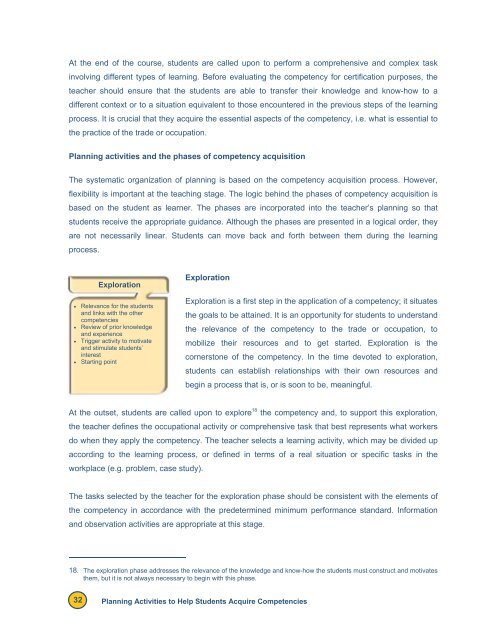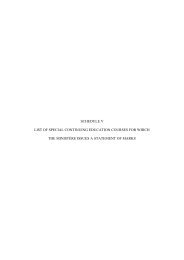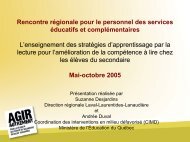Reference Framework for Planning Learning and Evaluation Activities
Reference Framework for Planning Learning and Evaluation Activities
Reference Framework for Planning Learning and Evaluation Activities
Create successful ePaper yourself
Turn your PDF publications into a flip-book with our unique Google optimized e-Paper software.
At the end of the course, students are called upon to per<strong>for</strong>m a comprehensive <strong>and</strong> complex task<br />
involving different types of learning. Be<strong>for</strong>e evaluating the competency <strong>for</strong> certification purposes, the<br />
teacher should ensure that the students are able to transfer their knowledge <strong>and</strong> know-how to a<br />
different context or to a situation equivalent to those encountered in the previous steps of the learning<br />
process. It is crucial that they acquire the essential aspects of the competency, i.e. what is essential to<br />
the practice of the trade or occupation.<br />
<strong>Planning</strong> activities <strong>and</strong> the phases of competency acquisition<br />
The systematic organization of planning is based on the competency acquisition process. However,<br />
flexibility is important at the teaching stage. The logic behind the phases of competency acquisition is<br />
based on the student as learner. The phases are incorporated into the teacher’s planning so that<br />
students receive the appropriate guidance. Although the phases are presented in a logical order, they<br />
are not necessarily linear. Students can move back <strong>and</strong> <strong>for</strong>th between them during the learning<br />
process.<br />
Exploration<br />
• Relevance <strong>for</strong> the students<br />
<strong>and</strong> links with the other<br />
competencies<br />
• Review of prior knowledge<br />
<strong>and</strong> experience<br />
• Trigger activity to motivate<br />
<strong>and</strong> stimulate students’<br />
interest<br />
• Starting point<br />
Exploration<br />
Exploration is a first step in the application of a competency; it situates<br />
the goals to be attained. It is an opportunity <strong>for</strong> students to underst<strong>and</strong><br />
the relevance of the competency to the trade or occupation, to<br />
mobilize their resources <strong>and</strong> to get started. Exploration is the<br />
cornerstone of the competency. In the time devoted to exploration,<br />
students can establish relationships with their own resources <strong>and</strong><br />
begin a process that is, or is soon to be, meaningful.<br />
At the outset, students are called upon to explore 18 the competency <strong>and</strong>, to support this exploration,<br />
the teacher defines the occupational activity or comprehensive task that best represents what workers<br />
do when they apply the competency. The teacher selects a learning activity, which may be divided up<br />
according to the learning process, or defined in terms of a real situation or specific tasks in the<br />
workplace (e.g. problem, case study).<br />
The tasks selected by the teacher <strong>for</strong> the exploration phase should be consistent with the elements of<br />
the competency in accordance with the predetermined minimum per<strong>for</strong>mance st<strong>and</strong>ard. In<strong>for</strong>mation<br />
<strong>and</strong> observation activities are appropriate at this stage.<br />
18. The exploration phase addresses the relevance of the knowledge <strong>and</strong> know-how the students must construct <strong>and</strong> motivates<br />
them, but it is not always necessary to begin with this phase.<br />
32 <strong>Planning</strong> <strong>Activities</strong> to Help Students Acquire Competencies




